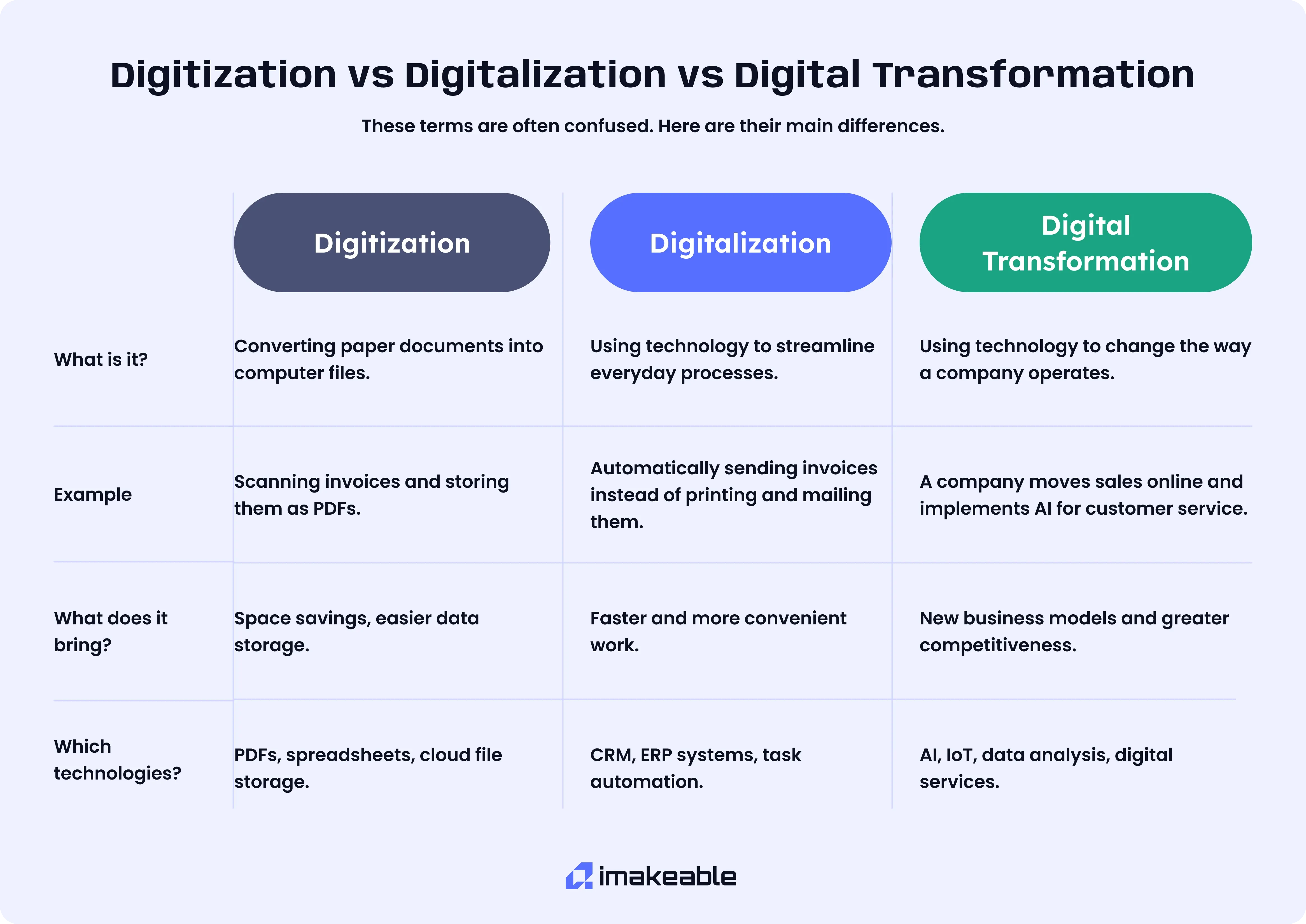

What is digital transformation?
Digital transformation is the process of integrating digital technologies into all areas of a company’s operations. It involves not only the implementation of new IT systems but also fundamental changes in how the organization functions and interacts with customers. Its goal is to optimize processes, improve efficiency, and deliver better user experiences. Digital transformation may include automation, data digitization, and the introduction of new technology-based business models.
How does digital transformation differ from digitization and digitalization?
These three terms are often used interchangeably, though they refer to different stages of technological change in an organization. Each refers to a different and often significantly distinct scope of technology usage within a company.
1. Digitization – converting analog data to digital format
Digitization is the most basic stage and involves converting physical documents or analog data into digital format. For example, it can mean:
- Scanning paper invoices into PDF files.
- Storing documents in the cloud instead of in binders.
- Replacing handwritten accounting records with Excel spreadsheets.
Digitization does not change the way the company operates – it only facilitates storing and accessing information. Processes remain the same but are less time-consuming due to the elimination of paper documentation.
2. Digitalization – using technology to optimize processes
Digitalization goes a step further than digitization. It means implementing technology to automate and improve existing business processes. It is not yet a full transformation but an improvement in operational efficiency through digital tools.
Examples of digitalization:
- Instead of scanning invoices and storing them in the cloud (digitization), the company implements an OCR system that automatically reads the data and books it in an ERP system.
- Electronic document workflows replace traditional signing and passing of paper versions.
- Implementing CRM systems to manage customer relationships, replacing Excel spreadsheets.
Digitalization does not fundamentally change the company’s business model, but it allows it to operate faster, more efficiently, and more effectively.
3. Digital transformation – changing the company’s operating model
Digital transformation is the most advanced stage. It’s not just about introducing technology but changing the entire way a company operates and delivers its products and services.
Examples of digital transformation:
Netflix – transformed from a DVD rental company into a global streaming platform.
Tezeusz – one of the largest antiquarian bookstores in Poland, underwent digital transformation by automating sales processes and moving its offer to e-commerce.
InPost – instead of traditional courier services, it revolutionized the market with parcel lockers and advanced logistics systems, significantly speeding up the delivery process.
Digital transformation is not just the implementation of technology, but also a change in strategy, processes, and organizational culture. It requires companies to be flexible, ready for change, and open to new business models.

Why Are Companies Investing in Digital Transformation?
Companies implement digital transformation to increase efficiency, reduce costs, and better adapt to market changes.
A study by Forbes Insights and Hitachi Data Systems titled “How to Win at Digital Transformation”, published in 2016, included 573 senior executives from North America, Latin America, Europe, and Asia-Pacific. The results showed that for 50% of respondents, digital transformation was their top strategic priority.
More recent data comes from the EY report “Digital Transformation 2024”, published in July 2024. The survey was conducted in Q1 2024 among 494 medium and large enterprises in Poland, representing industries such as manufacturing, logistics, finance, and retail. The results show that 64% of the surveyed companies rate their level of advancement in digital transformation as high or very high.
Additionally, the KPMG report “Business Digital Transformation Monitor – 2024 Edition” indicates that the percentage of companies with a formal digital transformation strategy increased by 6 percentage points, reaching 27%. One-third of companies plan to increase spending on digital transformation in the coming year, and 18% intend to hire new personnel to support this area of development.
These findings suggest that digital transformation remains a key priority for many organizations, and its importance continues to grow over time.
How does technology impact financial performance?
Digital transformation primarily enables companies to stay competitive, grow faster, and increase profitability. Industries experiencing the most rapid digital transformation today include manufacturing (Industry 4.0), e-commerce, and FinTech.
Digital transformation increases competitiveness, accelerates growth, and improves profitability. The three fastest-changing industries are manufacturing, e-commerce, and FinTech.
In manufacturing, Industry 4.0 dominates – the integration of automation, IoT, and data analytics. Industrial robots, predictive maintenance, and smart production management systems reduce costs and minimize downtime. Globally, companies implementing these solutions report 20–30% productivity gains.
In e-commerce, artificial intelligence and marketing automation optimize the shopping process. Personalized offers and dynamic pricing can increase conversion rates by up to 50% (McKinsey, 2023).
FinTech is developing digital customer service channels. Mobile apps, chatbots, and automated data analysis speed up processes and improve user satisfaction. Banks that invest in digitization grow their customer base by 10–25% annually.
Digital transformation enables companies to:
1. Reduce costs and expand their business
Automation and digitalization eliminate errors and reduce manual workload, leading to lower operating costs. However, as noted in the EY report mentioned earlier, cost optimization is not the only motivation. 49% of companies cite business growth and expansion into new markets as key drivers of digital transformation.
2. Streamline and optimize processes
Digitization not only accelerates task completion but also forces a review and optimization of existing processes. In practice, implementing automation often reveals areas in need of fundamental change. For example, implementing automated offer generation may lead to rethinking what information is key to customers and whether the current presentation model is optimal.
3. Create new business models
Digital transformation opens the door to building new revenue streams and reshaping existing business lines. A popular example is the development of B2B e-commerce platforms. According to Gartner, 24/7 self-service solutions that eliminate the need for contact with a sales representative and simplify purchasing are increasingly replacing traditional sales methods. A similar approach in other industries can give companies a competitive edge and increase their customer base.
Which industries and companies can benefit from digital transformation?
Digital transformation benefits many sectors of the economy, enabling companies to increase efficiency, improve customer service, and introduce innovative business models. Below are sectors that have already successfully adopted digital technologies, examples of companies that adapted their operations, and consequences for those that fail to keep up with digital change.
Sectors actively using digital technologies:
- Retail: The use of e-commerce platforms and data analytics helps better understand customer needs and personalize offerings.
- Financial services: Banks and financial institutions are implementing mobile solutions and blockchain technologies to increase security and service accessibility.
- Manufacturing: Integration of IoT and automation of production processes improves productivity and reduces costs.
Examples of companies that adapted:
- Domino’s Pizza: Revolutionized food ordering by introducing online platforms, mobile apps, and real-time order tracking.
- Under Armour: The sportswear brand built a fitness app ecosystem, collecting user data and offering personalized workout recommendations.
- Netflix: The streaming platform transformed the content distribution model by using data analytics to create and recommend personalized content.
Consequences of failing to adapt:
Companies that do not embrace digital transformation may face the following challenges:
- Loss of competitiveness: Businesses resistant to change may be overtaken by more innovative competitors and lose market share.
- Customer dissatisfaction: Modern consumers expect convenient and personalized services; lacking digital solutions can lower satisfaction and loyalty.
- Higher operating costs: Without automation and modern tools, businesses may face higher operating expenses and lower efficiency.
Inability to execute a digital transformation can result in wasted resources, organizational effort, and time, as well as falling behind in customer engagement, process efficiency, and innovation.
How to start a digital transformation?
Starting a digital transformation is a process that requires careful planning, avoiding common mistakes, and effectively tracking progress.
First steps: analysis, planning, investments
- Analyze the current state: Conduct a company audit to identify current business processes, technologies in use, and areas in need of improvement.
- Define goals and strategy: Set clear transformation goals, such as improving operational efficiency or enhancing customer service. Develop a strategy that includes implementation stages and the necessary resources.
- Invest in the right technologies: Choose tools and systems best suited to your company’s needs – such as ERP systems, cloud platforms, or AI-based solutions.
Mistakes that can increase costs and delay implementation
- Lack of a clear strategy: Vague goals can lead to scattered efforts and inefficient use of resources.
- Insufficient employee engagement: Skipping training and internal communication can lead to resistance and decreased morale.
- Ignoring data analysis: Making decisions without relying on solid data can lead to poor investments and financial losses.
How to Measure the Effectiveness of Change?
- Key Performance Indicators (KPIs): Define measurable metrics such as process completion time, customer satisfaction levels, or reduction in operating costs.
- Regular progress monitoring: Systematically analyze results against your set goals to make adjustments to your strategy when needed.
- Feedback from employees and customers: Collect input from your team and service recipients to assess the real impact of changes on company operations and brand perception.
Remember: Digital transformation is a continuous process that requires flexibility and readiness to adapt to new challenges and technologies.
What can we do for you?
Web Application Development
Build Lightning-Fast Web Apps with Next.js
AI Development
Leverage AI to create a new competitive advantage.
Process Automation
Use your time more effectively and automate repetitive tasks.
Digital Transformation
Bring your company into the 21st century and increase its efficiency.


Digital Transformation 101: What It Is and Why It Matters
Explore digital transformation’s impact on business, covering drivers like technology and consumer demand, key areas of change, challenges, and future trends.
7 minutes of reading

Michał Kłak
21 September 2024

The Deep Impact of Digital Transformation on Organizational DNA
Discover how digital transformation redefines organizational DNA, enhancing culture, operations, and customer experience.
8 minutes of reading

Michał Kłak
16 December 2024

Digital Transformation: Strategies for Thriving in the Digital Age
Discover how AI process automation enhances productivity, reduces errors, and scales operations while tackling data security and resistance to change.
7 minutes of reading

Maksymilian Konarski
25 September 2024
